"People don't know what they want until you show it to them." Steve Jobs once said that, probably not about the email I recently got announcing a clearance sale on ergonomic slippers. But in an instant, I knew there was nothing I wanted (and, frankly, deserved) as much as those slippers.
This is the magic—or perhaps the audacity—of eCommerce email marketing.
While these messages might seem like not-so-subtle manipulation, they're a testament to the power of tailored communication. eCommerce emails attempt to highlight products that might genuinely appeal to the recipient. And more often than not, they hit the mark, tapping into what consumers want even before they know they want it.
In this post, I dive into this world of pixel-powered persuasion to find out what it can look like, how it's done, and why you suddenly think you need a $200 smart toothbrush.
Table of contents:
What is eCommerce email marketing?
eCommerce email marketing is the strategic use of email to promote products, build relationships, and drive customer engagement to boost sales in eCommerce.
Unlike traditional marketing channels like billboards or TV ads, which broadcast messages to a sweeping audience, eCommerce email marketing targets a highly specific audience. This strategy is all about personalized communication, from tailored product recommendations to special birthday discounts, making it incredibly effective for converting prospects into customers and one-time buyers into loyal fans.
Let's not confuse eCommerce email marketing with other forms of email marketing. While the latter might focus on brand storytelling, educational content, or general updates (think newsletters and eBooks), eCommerce email marketing is direct, sales-oriented, highly customized, and drives swift action. It's the difference between a personal trainer and a life coach. They're both in your corner, but one is all about immediate action and results, whereas the other is about long-term growth and understanding.
What are the benefits of eCommerce email marketing?
eCommerce email marketing is one of the most effective and efficient eCommerce marketing strategies because it's personal, direct, and cost-effective. Some of its many advantages include:
High ROI: Email marketing consistently boasts one of the highest returns on investment (ROI) among digital marketing channels, especially when it comes to eCommerce. Sending emails, especially in bulk, is relatively inexpensive. When compared to the costs associated with traditional advertising methods like print or television ads, email marketing offers a more affordable way to reach a large audience.
Increased customer retention: Retaining an existing customer is easier than acquiring a new one. Most visitors won't return to your online store unless you do something to entice them back. Building mailing lists and sending individualized email content and offers helps retain the visitors you worked hard to attract. This keeps your brand top of mind and nurtures long-term relationships, leading to increased spending over time. Keeping that connection alive is the gift that keeps on giving.
Direct customer communication: Once you build a mailing list, you can communicate with your audience directly. Your messages will reach their devices immediately without third-party interference—no Facebook, with its moody algorithms showing your post to maybe three people unless you pony up like some kind of bridge troll.
Immediate results: Email campaigns, especially flash sales or limited-time offers, can drive immediate traffic and sales on an eCommerce shop. The immediacy of email allows for quick reactions and impulse purchases.
10 eCommerce email marketing examples
Think of eCommerce email marketing like Spotify's playlist model. Whether it's introducing you to new artists through Discover Weekly (product recommendations) or playing the latest release from your favorite artist through Release Radar (product launch), these emails show how brands set the mood and get the crowd dancing (opening their wallets).
1. Welcome emails
Welcome emails are essentially the introductory handshake in your virtual relationship with new subscribers. They serve a dual purpose: confirm the email address your subscriber gave is legit and make a grand first impression of your brand (while subtly hinting at what they can expect from you in terms of future communication).
Keep the tone of your welcome emails hospitable and inviting, and let your brand voice shine. But above all, be thankful.
Well-crafted welcome emails can increase customer engagement and secure a place for you in their hearts forever. You're not just another internet rando—you're a brand rando, but a cool one that has something they want—so it's important to nail that welcome email.
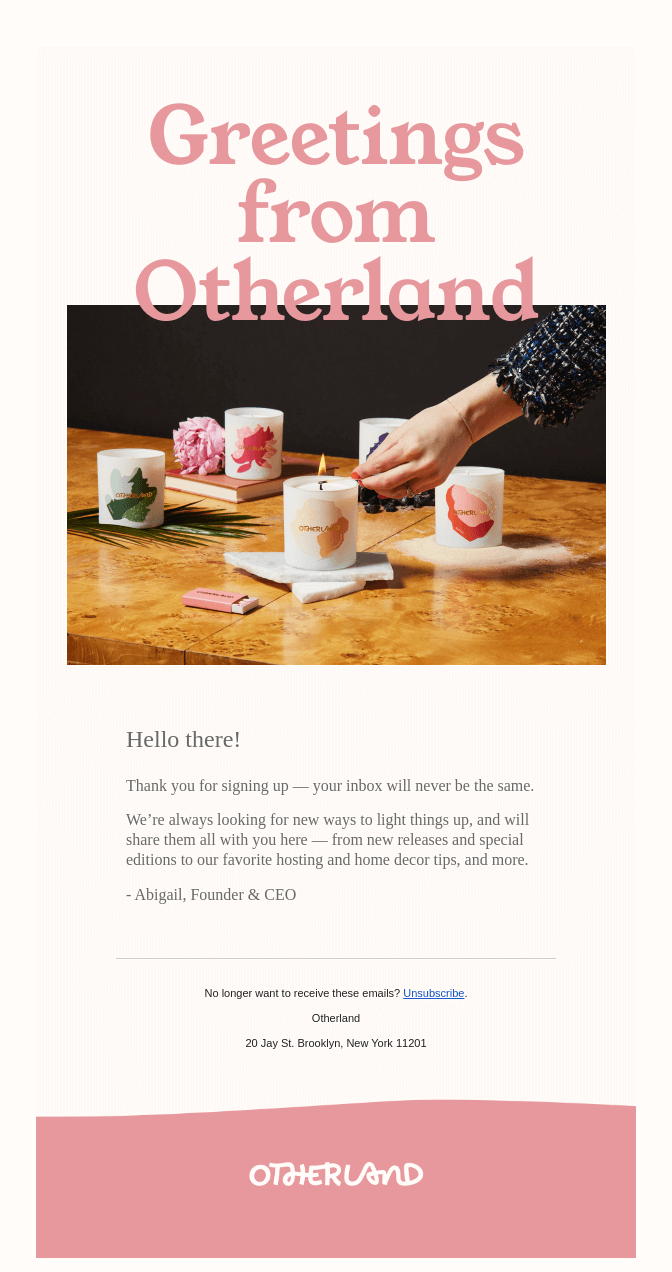
2. Promotional emails
These emails focus on specific offers, discounts, or events to create urgency and encourage immediate action. They're like the main dish when you're hungry for sales. But don't let them hog the spotlight—balance them with other emails if you want a well-rounded marketing strategy that doesn't make your customers feel like deer during open season.

3. Abandoned cart emails
These emails are the ultimate smooth talkers, trying to win back those customers who got oh-so-close to buying something but vanished without a trace. They act as a re-engagement tool designed to mitigate cart abandonment rates.
Keep these emails simple and straight to the point. Personalize them by using the customer's name and images of the products they've left behind. Make that CTA big and bold, and maybe add a limited-time discount if you're feeling generous. You don't want to clutter up the email with anything that can distract them—you're aiming for a one-way ticket back to checkout.
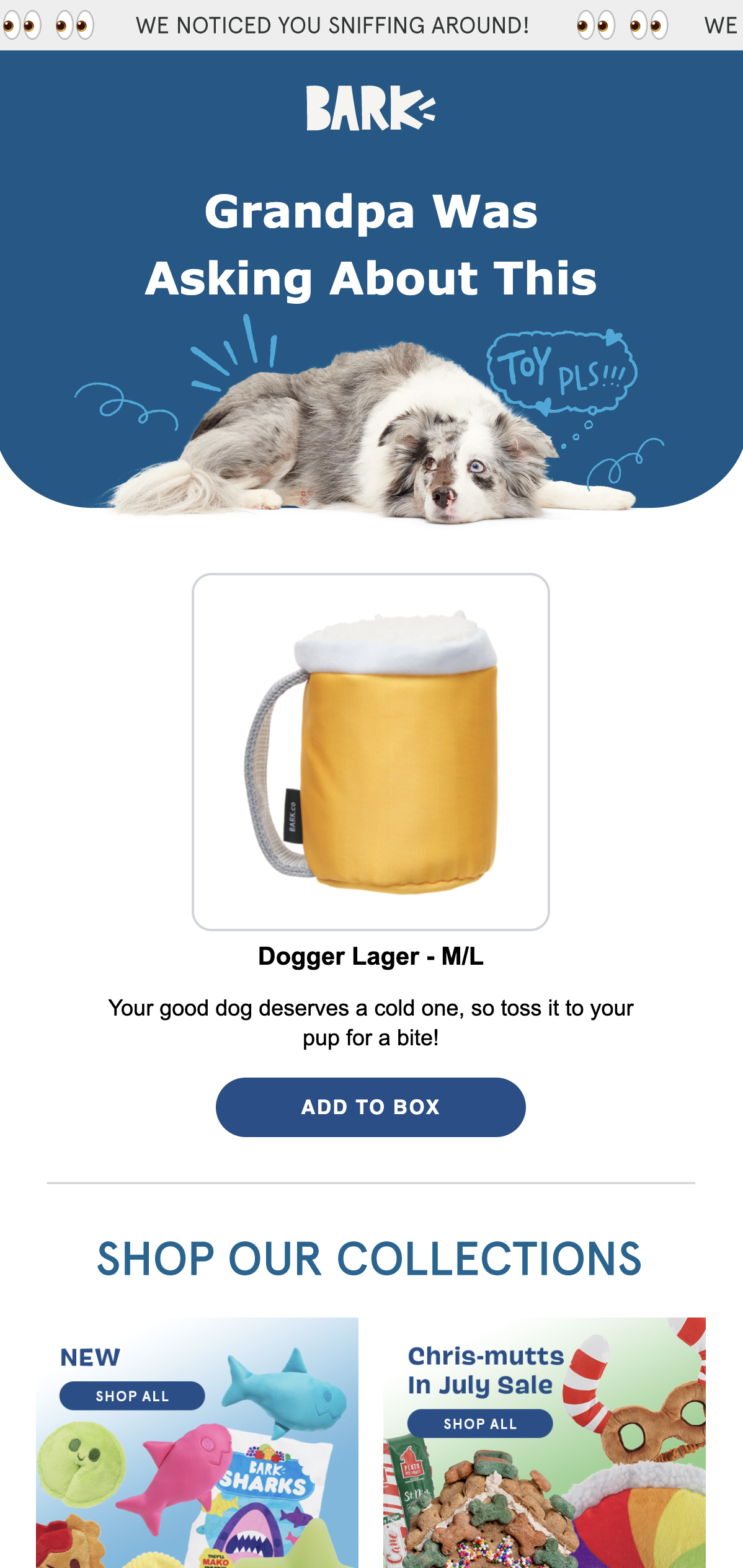
4. Purchase follow-up emails
When you hear "purchase follow-up," you might instantly picture a lackluster "Thank you!" email, robbing you of another tiny fraction of your precious time. But it should be so much more than that. A great purchase follow-up is more like, "Hey there! We noticed you bought this product. How's it treating you? Was it a hit? A miss? Did it spark joy? Swing by our site and drop a review."
The beauty of sending purchase follow-up emails lies in their ability to recap a transaction and reignite the conversation. Think of it as texting a friend after a night out, making sure they got home ok.
The post-purchase phase is a major landmark in the customer journey, often neglected in favor of acquisition-focused strategies. However, this is when customers are most engaged. Use this opportunity to solicit feedback while their experiences are fresh in their minds. Spotlight purchased items and sprinkle in some personal touches. It's like leaving the porch light on, inviting your customers to pop by for a chat.

5. Product recommendation emails
Product recommendation emails utilize machine learning or rule-based algorithms to provide tailored product suggestions based on the customer's previous behavior. It's like having Miss Cleo herself as a personal shopper in your inbox. Product recommendations enhance user experience, potentially increasing average order value. Consider including user-generated content and product reviews. People want to know that someone else tested the waters for them.
It's all about making your customer's online retail therapy feel more like a customized spree and less like a random scroll.
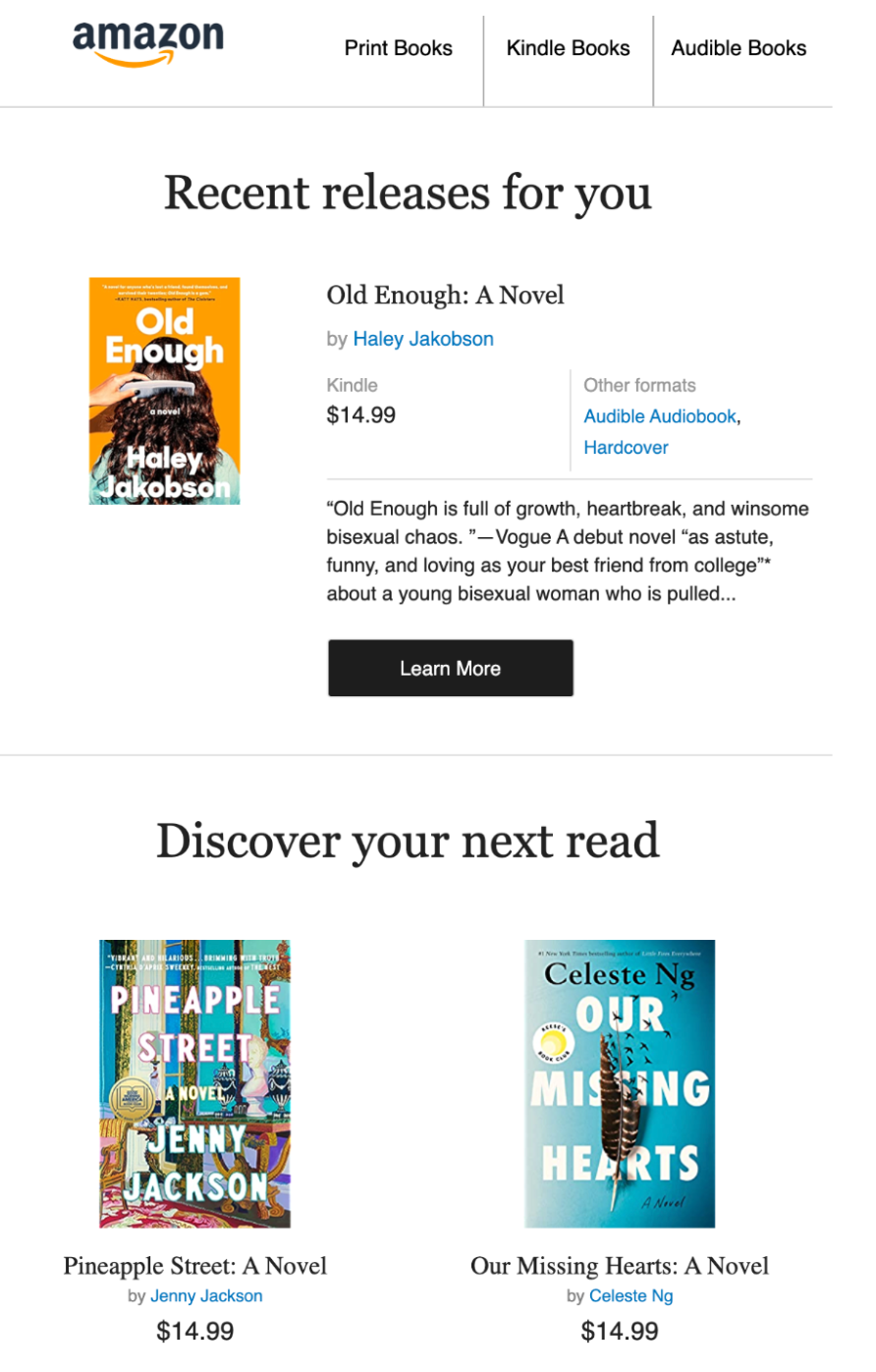
6. Win-back emails
Win-back emails target lapsed customers who haven't interacted with your brand over a set period. By deploying the age-old anxieties of scarcity and FOMO (fear of missing out), they aim to reignite interest and bring the customer back into the buying cycle. It's all about lighting a fire under them to rekindle that burning desire to buy whatever you're selling.
You want your win-back emails to be attention-grabbing, so spend extra time crafting a subject line. Use your customer's name, tell them you miss them (but not in a weird way), and sprinkle in an emoji or two. Keep things to the point in the body of the email, and offer up a special discount or free shipping for crawling back to you.
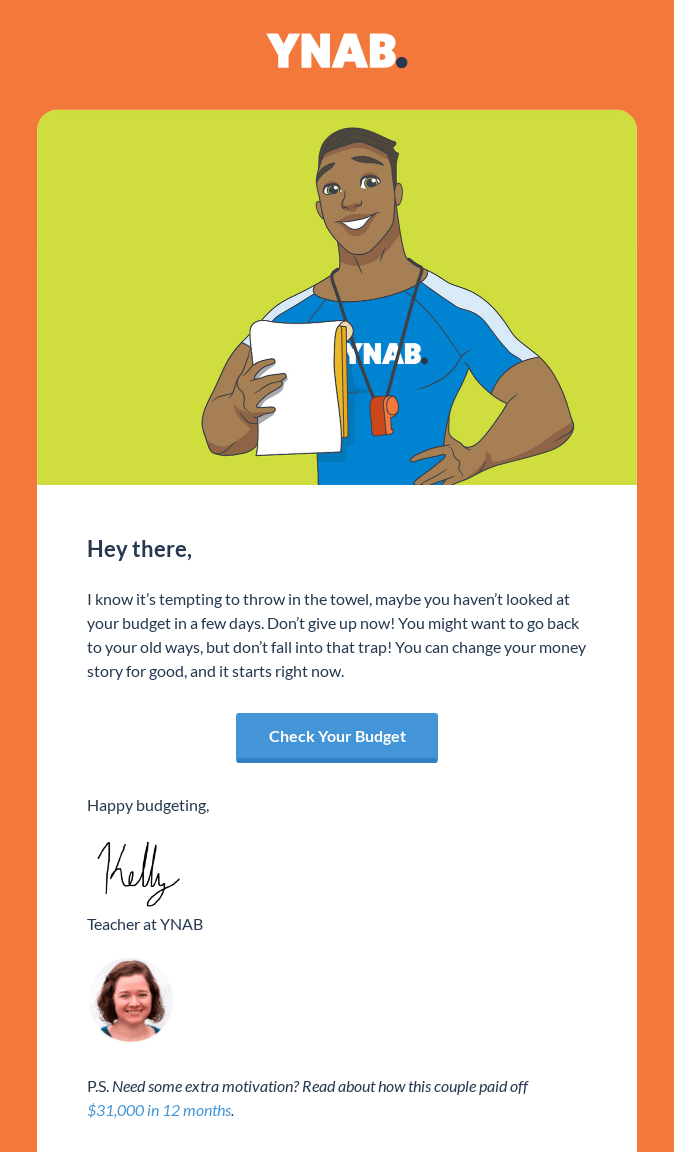
7. New product launch
Product launch emails have an uncanny ability to speak directly to the soul. They're an essential tool to ignite enthusiasm among brand evangelists. Just ask sneakerheads and Apple fans.
Before you launch a new product in your eCommerce store, use email to tease the product to your audience. Tell them you're cooking up something new, and offer a discount or a chance to preorder. This can help build anticipation around your launch and make customers feel like they have the inside scoop. Put your customers' desires in direct competition with their bank account.

8. Birthday emails
These are personalized messages sent to subscribers on or around their birthdays. Celebrating this personal milestone with the customer can foster a deeper emotional connection and enhance customer loyalty. Shamelessly butter them up with special discounts or freebies, which can increase conversion chances and make the customer feel appreciated and valued. Because nothing says appreciation quite like an automated email.
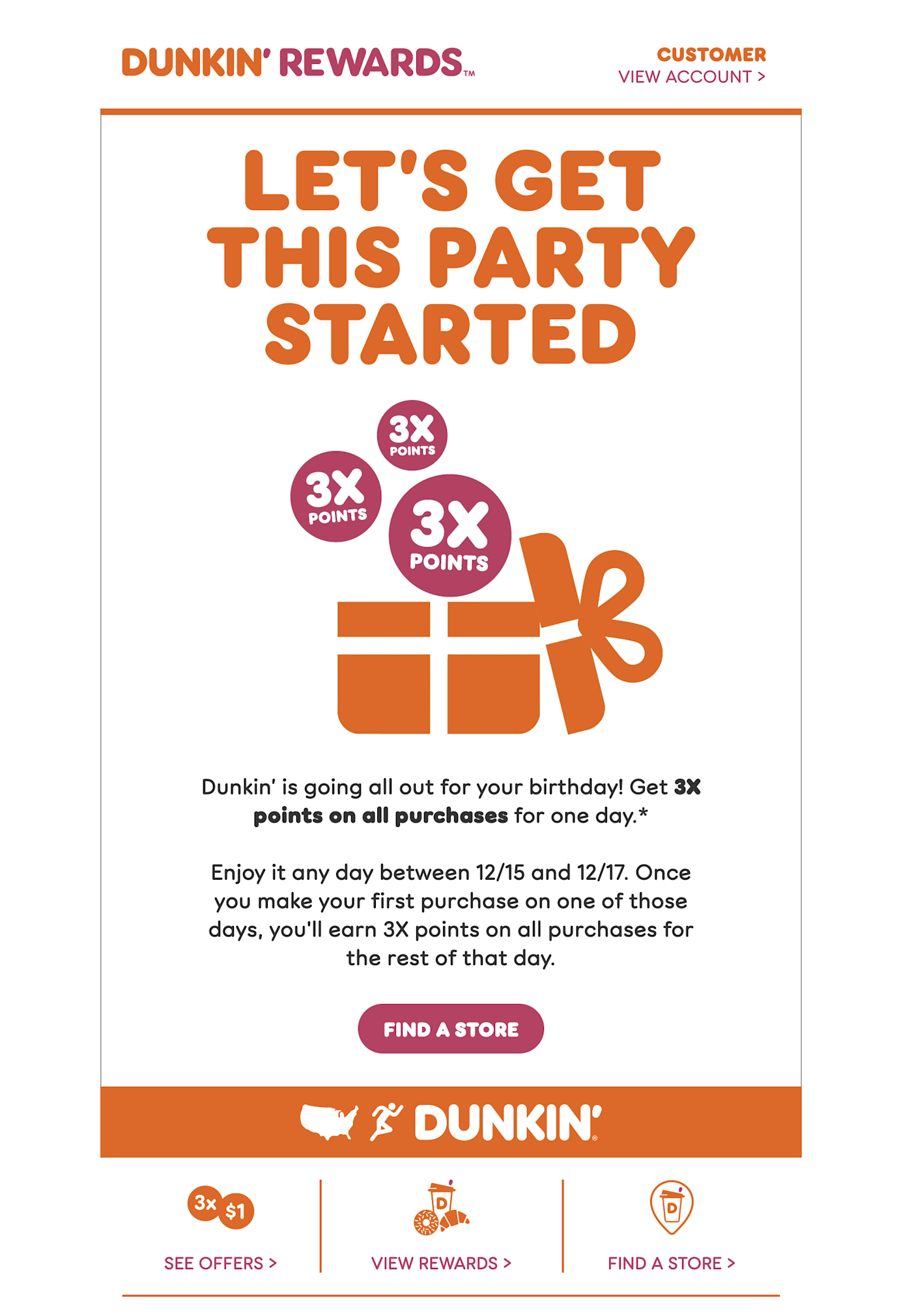
9. Back-in-stock emails
These multitaskers serve as a customer service tool as much as a marketing one. When a previously out-of-stock item becomes available again, back-in-stock emails swoop in at just the right moment to revive your customer's shopping journey like a phoenix rising from the ashes. They help resume the consumer's buying journey where it was interrupted.
If an item was a hot seller, let customers know. Tell them the stock is limited or that others are eyeing the same product. When the FOMO kicks in and they sense the clock's ticking, they're more likely to jump back into shopping mode.

10. Newsletter and other non-promotional emails
Although the goal of your email program is likely to generate sales, that doesn't mean every message needs to be a desperate "Buy this NOW!" plea. You know that one person from high school who now works as a "boss babe" peddling essential oils and only speaks to you in emoji-filled Facebook messages asking to join their downline? Don't be like that. Bombarding your audience with nonstop sales pitches is a one-way ticket to the "unsubscribe" button.
Keep the spark alive with your readers between purchases. Get into the weeds with detailed how-tos about using your products to make them feel like pros, showcase real-life inspiration that gets their creative juices flowing, or pull back the curtain and show off what's happening behind the scenes. This keeps your audience entertained and warms them up, making them more receptive to future hard-sell messaging.
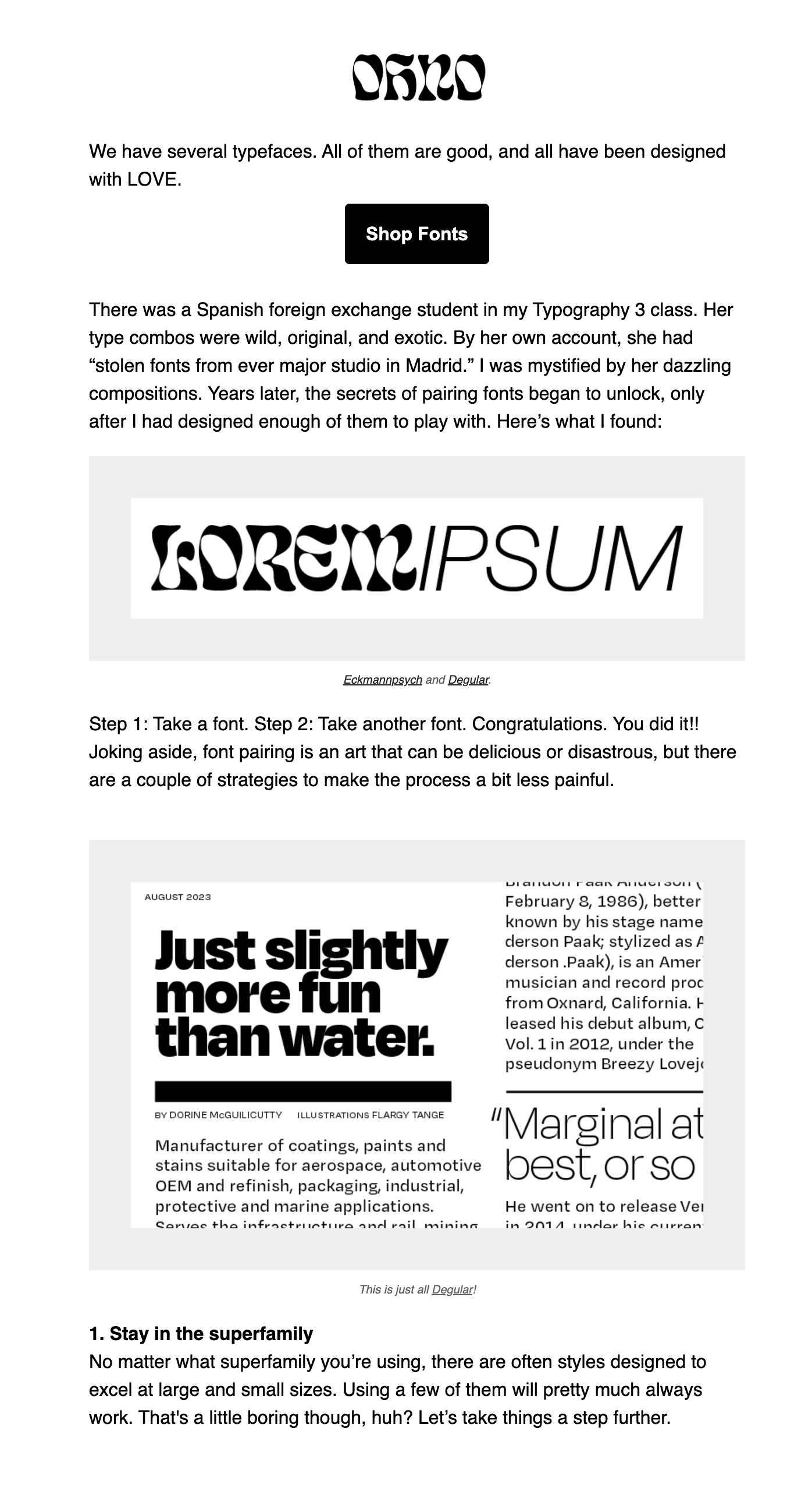
What should an eCommerce marketing email include?
Crafting an email that resonates with your audience requires a blend of aesthetics, information, and trust-building elements. Let's break down the essential components that elevate an eCommerce marketing email from "meh" to "shut up and take my money!"
Product imagery: Include high-quality images of promoted products, giving recipients a clear view of your offer. A compelling visual captures attention and evokes emotion, making the product more memorable.
Product descriptions: What are those shoes made of? Vegan leather? Unicorn hide? Include brief and compelling product descriptions, highlighting their features and benefits.
Clear call to action (CTA): Never send an email without a purpose, and include that purpose in your CTA. Use prominent buttons or links that guide the recipient to take a desired action. And, please, I am begging you, send recipients directly to a landing page where they can perform that action. (Pro tip: since you can't guarantee anyone will read your entire email, place the CTA in the middle of the message to ensure customers see it.)
Personalization: Tailor email content using the recipient's name, purchase history, or browsing behavior. For example, display product recommendations based on past purchases. Nothing says you care like, "Hey, remember those funky socks you bought? Here's a matching hat."
Price and discounts: Clearly display the product's price, especially if it's on sale. Light up your discounts like the Vegas Strip.
Scarcity indicators: Elements like "Only a few left in stock" or "Sale ends in three hours" create urgency. Make them panic a little. It's good for business.
Customer reviews: Showcase positive reviews or testimonials to build trust and encourage purchases. If Brenda from Ohio says those jeans changed her life, your customers are more inclined to believe her than a faceless brand.
Easy navigation: Life's complicated enough. If you're showcasing multiple products, ensure the email layout allows for easy browsing. Throw in some catchy headlines and visuals to make each section pop, ensuring your readers don't miss out on any of the cool stuff you've got lined up.
Secure checkout badge: Assure customers that their transactions will be secure. In a world of uncertainties, let them know their credit card details are one thing they don't have to worry about. This should go without saying, but only add badges you have earned.
Transparent shipping and return information: Clearly state shipping costs, delivery times, and return policies. Your customers want to know how fast they can get it and how long they have to regret it.
Cross-sell and upsell opportunities: Recommend complementary products or higher-value items. Give them options. Expensive ones.
Loyalty programs: Promote any loyalty or rewards programs to encourage repeat purchases. For instance, you could introduce a points system where customers earn points with every dollar they spend, which they can later redeem for exclusive products or discounts. Dangle that carrot.
Contact information: Include a way for recipients to get in touch, whether it's a customer service email, phone number, or chat option, because apparently there are still people out there who believe in the concept of human interaction.
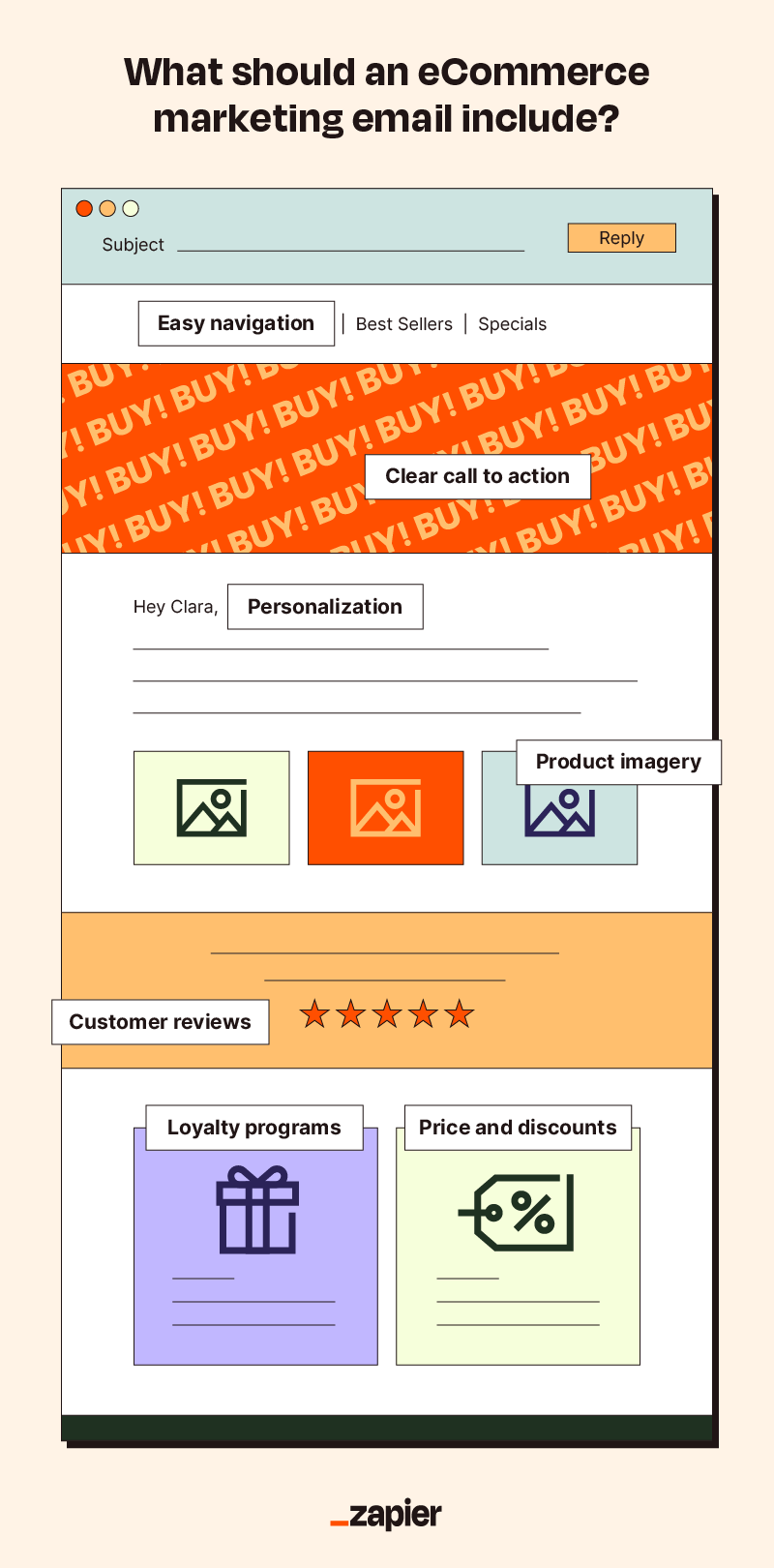
eCommerce email marketing best practices
These eCommerce email marketing tips aren't definitive solutions, but they're a pretty solid nudge in the right direction. It's on you to find what works best for your organization.
Segment your email list
Email segmentation allows you to group subscribers based on shared characteristics and deliver customized content. Your audience isn't a monolithic blob. They expect you to listen to them and respond with messages tailored to their individual interests. Group them by factors like interests, needs, age, gender, location, and past purchases to ensure each email hits just the right note.
Try personalizing based on the little details for a magic touch. Don't send customers in the Southern Hemisphere an email about your summer special in June while they're bundling up for the winter. It's all about making every email feel like a personalized high-five.
Focus on quality over quantity
How many emails do you send your subscribers each month? Trick question! Different segments receive a different number of emails at different cadences. That means there's no single ideal email frequency and, therefore, no magic number.
Flooding subscribers with a barrage of generic emails? That's a quick ticket to making your subscribers hate you. Prioritize quality over sheer volume. By segmenting your audience based on behavior, purchase history, and other parameters, you can tailor content that resonates and engages. Quality emails, crafted with precision and relevance, tend to yield better conversion rates. While bombarding readers with emails might get you noticed for a second, it's meaningful content that keeps people around.
Regular, value-packed email communication can help build trust between you and your customers. Over time, this trust can increase loyalty and advocacy, turning casual subscribers into your brand's cheerleaders.
Consider compliance
eCommerce email marketing, as coined by marketing expert Seth Godin, is all about "permission marketing." Visitors must choose to subscribe to your mailing list of their own volition, basing the relationship built between your brand and its customers on this permission.
While the U.S. CAN-SPAM Act of 2003 sets basic guidelines for email marketing, simply following it doesn't shield you from potential issues like spam complaints or blocklisting. This law mandates several requirements for email marketers, like including an unsubscribe link, honoring opt-out requests promptly, and avoiding deceptive practices. Always ensure you're compliant to maintain subscriber trust and avoid legal complications.
Depending on where you're operating and your readers' locations, email communications might be subject to other laws, including:
Health Insurance Portability and Accountability Act (HIPAA) (U.S.)
California Online Privacy Protection Act (U.S.)
Canadian Anti-Spam Law (CASL) (Canada)
Data Protection Act (U.K.)
ePrivacy Directive (EU)
Telemedia Act (Germany)
Article L. 34-5 (France)
Italian Personal Data Protection Code (Italy)
SPAM Act 2003 (Australia)
Be mindful of promotional content in transactional emails
The main objective of transactional emails is to convey essential purchase information or account details to the customer. Transactional emails are so commonplace that they're not permission-based. This means you can send them to those who aren't subscribers, and you don't necessarily have to include an opt-out option.
According to the FTC, transactional emails should consist only of content that:
Enables, confirms, or completes a purchase, sign-up, or other transaction the recipient has agreed to
Gives warranty, safety, recall, or security details about a product or service purchased by the recipient
Informs the recipient of changes in their membership, subscription, account, loan, or other ongoing business relationships; updates on their status in that relationship or regularly shares account balance details
Shares details about employment or associated benefits
Provides goods or services as part of a previous agreed-upon transaction
Their high open rates make transactional emails an eCommerce marketer's dream. In the U.S., it's not uncommon to see promotional content in these emails. However, it's essential to remember that the primary purpose of these emails is to inform. Whether it's a shipping update, a password reset, or an order confirmation, the main info should always be front and center. Think of the promotional content as the side dish, not the main course.
Always keep a pulse on the ever-changing email regulations worldwide. Some countries, like Germany, keep a tighter leash, requiring explicit customer consent before slipping in any promotional content. Without that thumbs up, these emails must be strictly transactional.
Consult AI
AI tools have revolutionized eCommerce email marketing, serving up tailored solutions that get your customers clicking. Here's the scoop on how it can support your eCommerce email marketing strategy:
Buyer persona generation: When you feed AI tools data from customer reviews, feedback, and purchase histories, they can help create detailed buyer personas. These personas can guide the type of content, offers, and products you highlight in your emails. Try asking ChatGPT for a buyer persona based on your business. It's like if the Netflix algorithm and your favorite online store had a baby.
Predictive personalization: AI can analyze a customer's browsing and purchase history to predict what they might be interested in next. For instance, if a customer often buys athletic shoes, AI can trigger an email showcasing the latest running apparel collection.
Dynamic pricing emails: AI can monitor a user's interaction with products, then send emails with special discounts or offers for items they've shown interest in but have yet to purchase. For example, if a user has viewed a particular dress multiple times but hasn't bought it, AI can send a limited-time discount to sweeten the deal.
Optimal send times: Figuring out when to send emails is like trying to pick the best snack at 2 a.m.—it's an art and a science. AI can analyze when individual users are most likely to open and engage with emails, sending promotional messages when customers are daydreaming about shopping, not when they're in a meeting pretending to work.
Inventory-driven promotions: Got too many glittery boots? AI's on it, sending out promotional emails for overstocked items, optimizing your stock levels.
Feedback analysis: Use AI to analyze feedback from customers. It can process large volumes of text to identify common themes, sentiments, and suggestions, which can then inform your email marketing strategies. It's like your personal therapist, sifting through feedback and telling you what your customers are really feeling.
Personalized recommendations: Integrating AI with your eCommerce platform can allow it to play personal shopper by generating customized product recommendations for users based on their interactions and queries.
Interactive email content: Let AI turn your emails into a game night. Generate quizzes or interactive content for emails that lead to personalized product recommendations.
Language and tone adaptation: AI can adapt the language and tone of emails based on the target audience. Whether you're talking to hip Gen Zers or sophisticated Boomers, it's got you.
To integrate AI features, ensure that your eCommerce website builder or email marketing tool has AI capabilities or can easily integrate with third-party AI solutions.
Leverage trending topics
When brands address the latest Hollywood gossip or the meme of the hour, they demonstrate that they're not just isolated entities, but live and actively engage in the same world as their customers. It's not so much about being cool or trendy as it is about building that cozy "we're in this together" feeling.
Topical content often sparks conversations, debates, and discussions. By tapping into these conversations, brands can engage with their audience in meaningful ways, fostering a sense of community and belonging.
Shared cultural awareness, whether it's a nod to the latest binge-worthy TV show or a comment on a significant global event, creates relatability. This sense of connection isn't just heartwarming—it's beneficial for business. When customers feel seen and understood, they're more inclined to trust the brand, leading to increased loyalty and, ultimately, more sales.
Use email to supplement other marketing channels
eCommerce email marketing is suitable as a standalone strategy, but it's even better when de-siloed and integrated into an omnichannel marketing experience. Consumers don't separate your brand into different marketing channels. They see one brand and expect organizations to treat them as one person regardless of which channel they're interacting with.
You can also use email marketing to expose your customers to other channels. Drop a hint about that Instagram giveaway or website redesign. Flip the script and use those other platforms to boost your email list.
Think of it as a crossover episode of "Law & Order." Sure, email marketing is fine on its own, but when you see Lennie Briscoe share a screen with Benson and Stabler, you know something epic is about to happen.
Here are some ways you can apply these strategies:
Proudly display an email opt-in form on your website. The homepage, footer, and checkout page are all great spots for it.
Use elements of the titles of successful blog posts as subject lines and preview text.
Include links to your social media profiles and encourage readers to share your email content with their followers.
Use your email list to target subscribers and lookalike audiences for social media ads.
Offer e-receipts for in-store purchases.
Use email messaging to recruit seasonal employees.
Use email copy as a test bed for messages to use in other channels' campaigns.
Have workers report negative customer interactions, so you can pause promotional emails to those customers, preemptively preventing unsubscribes and spam complaints in response to the bad experience.
Mix those marketing channels like Dick Wolf mixes crime-solving squads to give your customers an experience as glorious as Jack McCoy's eyebrows. Dun dun.
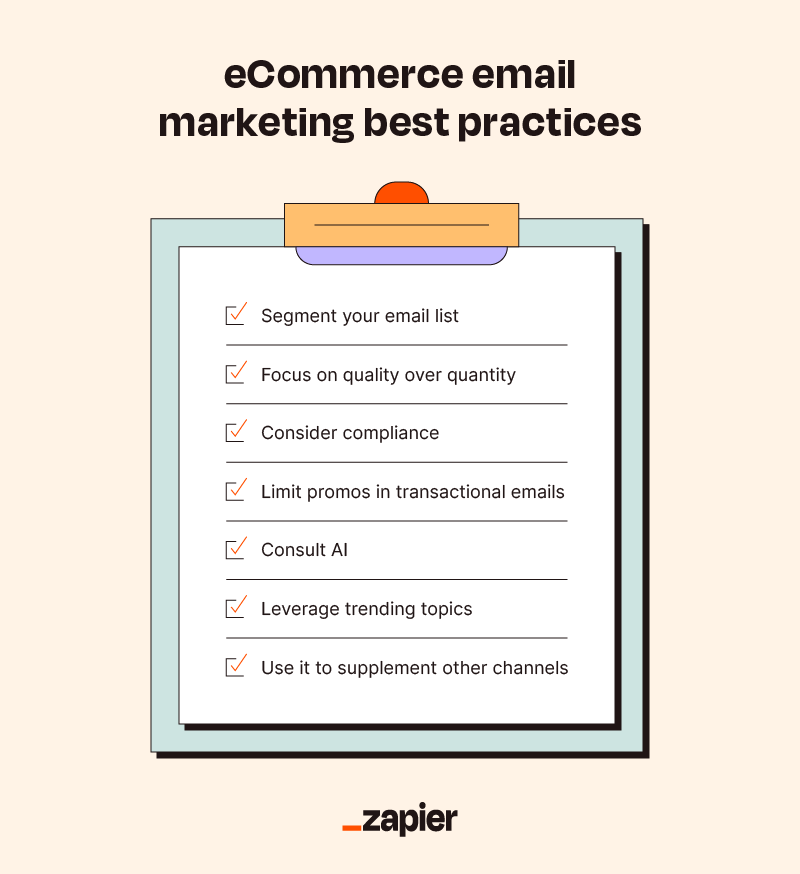
Automating your email marketing campaign
As the name suggests, eCommerce email automation automates email marketing so that you don't have to send a million emails by hand. Specifically, this means emails created once are sent automatically to the recipient at a designated time using a defined trigger linked to an event, date, or action.
There are four kinds of email triggers:
Action-triggered: This type of email is sent when a subscriber takes a particular action. Examples include confirmation emails and cart abandonment emails.
Inaction-triggered: These emails are sent when a subscriber didn't take a particular action within a certain timeframe. Examples include win-back emails or reactivation emails.
Date-triggered: These are sent ahead of an upcoming date. Examples include birthday emails or appointment reminder emails.
Machine-triggered: This type of email is sent when an internet-connected device detects a condition change. Examples include service-required emails and low-battery warnings.
Automated email marketing can also send entire email sequences (think drip marketing). For instance, you can set up a follow-up email to be sent automatically once an email has been opened, a link clicked, or a meeting is scheduled (because you're super busy and important). Conversely, suppose you sent a prospect an email with an enticing offer a few days ago, and it remains unopened in their inbox. In that case, it might make sense to send a "Remember that awesome thing you ignored? Well, here it is again" reminder.
When your recipients interact differently with a received email, automation paths can branch off. It's like a choose-your-own-adventure but for eCommerce marketing. Whether your recipients open your email or not dictates the next twist in the story.
With email automation, the only real limits are your own. The technology behind eCommerce email automation allows for an incredible degree of customization tailored to meet your audience's specific needs and preferences. Whether you're aiming for a straightforward sequence or a complex web of emails, the choice is yours. You can even set up a sequence as intricate as my skincare routine. (Just kidding, it's soap.)
Measuring success in email marketing for eCommerce
How do you know whether your eCommerce email marketing efforts are paying off or if you're just wasting pixels? Let me get to the meat of it and uncover the hidden metrics that can make or break your online business.
Key eCommerce email marketing KPIs
These days, email automation tools make tracking analytics a breeze. Learn what's working and what isn't by using an email marketing tool to keep tabs on your eCommerce email marketing campaign. Some common key performance indicators (KPIs) to help you gauge success and uncover areas that might need a little extra love include:
Open rate measures the percentage of recipients who opened the email out of the total number of emails sent, influencing sales opportunities. It provides insights into the effectiveness of the subject line and the sender's reputation. A higher open rate typically indicates compelling subject lines and optimal email delivery times.
Click-through rate (CTR) represents the percentage of email recipients who clicked on one or more links within the email relative to the total number of emails opened. It gauges the email's effectiveness in directing traffic to your website's product pages or special offers, leading recipients closer to making purchases.
Conversion rate denotes the percentage of recipients who took a desired action, such as making a purchase, after clicking a link in the email. A higher conversion rate indicates that the email effectively motivated recipients to act. This number shows how your emails are influencing your bottom line, be it snagging a deal from a flash sale email or rescuing a lonely item in a cart.
Bounce rate is the percentage of sent emails that failed to reach the recipient's inbox. Bounces can be "hard" (permanent issues like invalid addresses) or "soft" (temporary issues like a full inbox). A high bounce rate can harm the sender's reputation and may lead to email service providers flagging your emails as spam. A high bounce rate in eCommerce email marketing signifies missed sales opportunities, especially during key promotional periods.
Unsubscribe rate measures the percentage of subscribers who opted out of receiving future emails from the total number of emails sent. A rising unsubscribe rate for eCommerce brands indicates a potential disconnect between email content and subscriber interests. It's a heads-up that you might be losing some future shoppers.
A/B testing
Email A/B testing, or split testing, is a process used in eCommerce email marketing where you send two slightly different versions of an email (version A and version B) to separate groups of an email list. The goal is to prove the best version based on specific KPIs like open, click-through, or conversion rates. It's the "Chopped" of the email world, except you don't have to frantically whip up a dish made with black jelly beans and imitation crab meat.
Your gut might be shouting one thing, but customers often gravitate toward what's familiar, not necessarily what's best. When it comes to your emails, lean on data.
These days, email marketing tools make A/B testing a breeze to set up and can have a massive impact on your sales. Imagine the ripple effect a 5% uptick in your email's open and click-through rates can have on your bottom line.
Follow these simple steps for a successful A/B test:
Define goals: Before you can begin an A/B test, you'll have to set a clear goal. Without a plan, you're just making changes, not necessarily improvements.
Create email variants: Once you set a goal, create your email variants. Think of it like you're trying to nail the perfect recipe. Just as you wouldn't change every ingredient, don't overhaul your entire email (because how would you know what made it awesome?).
Select the test group: You can make this easy by doing a 50/50 split test where half your subscribers get one version of an email, and the other half get the other. You can then roll out the winning version to future recipients.
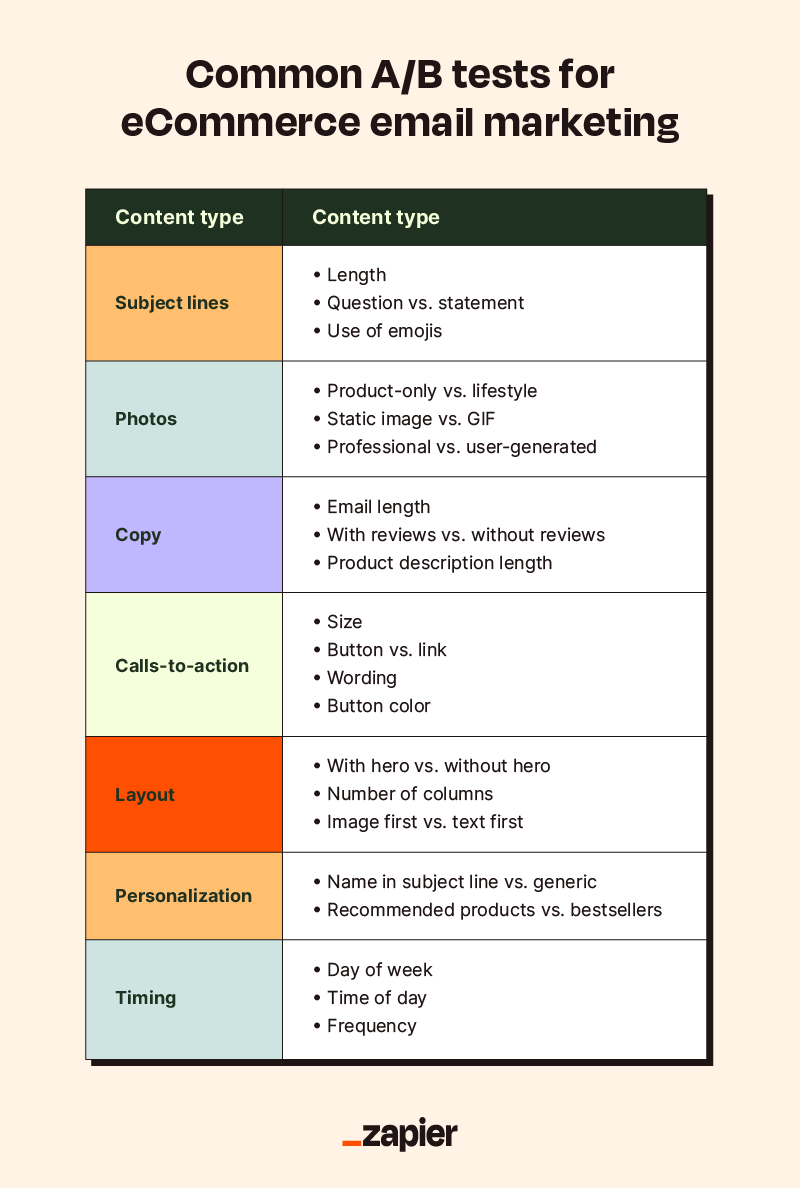
Powerful eCommerce email marketing tools
eCommerce email marketing software varies widely in features and costs. Whether you prefer easy-to-use tools for the occasional email marketing flow or a comprehensive, flexible service with loads of options, each app has its perks. Ready to pick out the email software that's right for you? Here are a few options, pulled from Zapier's lists of the best marketing automation software, best email newsletter software, and best email drip campaign software.
Klaviyo: Klaviyo is often the top choice for eCommerce due to its marketing integrations with platforms like Shopify and Magento. It offers advanced segmentation and automation specifically designed for online stores, making it a powerhouse for eCommerce email marketing.
Standout features: Deep eCommerce integrations and advanced segmentation
Omnisend: Omnisend is designed for eCommerce, offering not just email but also SMS and push notifications. Its multichannel approach makes it an excellent choice for businesses looking to reach customers in a multitude of ways.
Standout features: Extensive automation features and SMS and push notification integrations for a holistic approach
Mailchimp: While it has fewer advanced features than other tools on this list, Mailchimp is user-friendly and offers heaps of integrations. Its drag-and-drop builder and automation features are great for businesses starting out in eCommerce.
Standout features: User-friendly interface with drag-and-drop email builder and free plan for up to 500 subscribers
ActiveCampaign: With its CRM capabilities and advanced automation features, ActiveCampaign is suitable for eCommerce businesses looking for more than just email marketing.
Standout features: Combines email marketing with sales and CRM functions, making it easier to track customer interactions
HubSpot: HubSpot's comprehensive inbound marketing suite makes it a strong contender, especially for those already using HubSpot. Its email marketing tool integrates seamlessly with its CRM, making it great for businesses focusing on customer retention.
Standout features: Integrates with the HubSpot CRM, allowing for detailed tracking of customer interactions and tailored campaigns
Brevo (formerly Sendinblue): One of the more affordable options, Brevo's strength lies in its transactional emails and SMS campaigns, crucial for eCommerce operations.
Standout features: Free plan for up to 300 emails per day and a wide range of automations
eCommerce email marketing FAQ
It's truly impressive that you've made it this far yet still have a few burning curiosities. Let's plunge into the most-asked questions about eCommerce email marketing to clear up any lingering mysteries.
Is eCommerce email marketing worth it?
Absolutely. Email marketing is a top digital strategy in the eCommerce world. For every dollar spent, businesses can expect an ROI of $40. This efficiency surpasses many other methods, including platforms such as Facebook and X (formerly Twitter). With such impressive returns, email campaigns are essential for businesses looking to grow.
How often should I send eCommerce marketing emails?
Research suggests that 1-2 emails per week strikes the perfect balance. This frequency ensures consistent engagement with subscribers while minimizing the risk of email fatigue. It's crucial, however, to keep a close eye on key metrics like open and unsubscribe rates to fine-tune the sending cadence to your audience's preferences.
What is email segmentation, and why is it important in eCommerce email marketing?
Email segmentation in eCommerce is the practice of categorizing subscribers based on shared characteristics, behaviors, preferences, or demographics. This strategy ensures content is meticulously tailored and relevant to each recipient, enhancing engagement and conversion rates.
How do I build an email list for eCommerce marketing?
Start by offering enticing incentives such as discounts or freebies to motivate sign-ups. Implement pop-ups on key website pages and ensure an email sign-up option during the checkout process. Additionally, leverage the power of social media to promote your email list. Prioritize acquiring genuinely interested subscribers rather than merely focusing on quantity. This approach ensures a more engaged and responsive email audience.
How can I increase my email open and click-through rates?
Begin with crafting compelling subject lines and personalizing content. Segment your list for targeted messaging, ensure mobile optimization, and determine the best send times. Conduct A/B testing for optimal results, and always include clear CTAs. Relevant content is essential to higher click-throughs.
How do I get started with eCommerce email marketing?
To kickstart eCommerce email marketing:
Choose a trusted email marketing platform.
Focus on building a quality subscriber list and segment it for targeted messaging.
Use responsive email templates.
Craft engaging content that drives users to money pages.
Consistently analyze performance metrics to refine and optimize your strategies for maximum impact.
Take your eCommerce email marketing to the next level
Email remains one of the most powerful tools for eCommerce marketing. It allows for direct, personal, and wallet-friendly ways to connect with customers. With Zapier, you can enhance your email marketing strategy by integrating all the marketing tools in your arsenal. Learn more about how to automate your email marketing.
Related reading:






